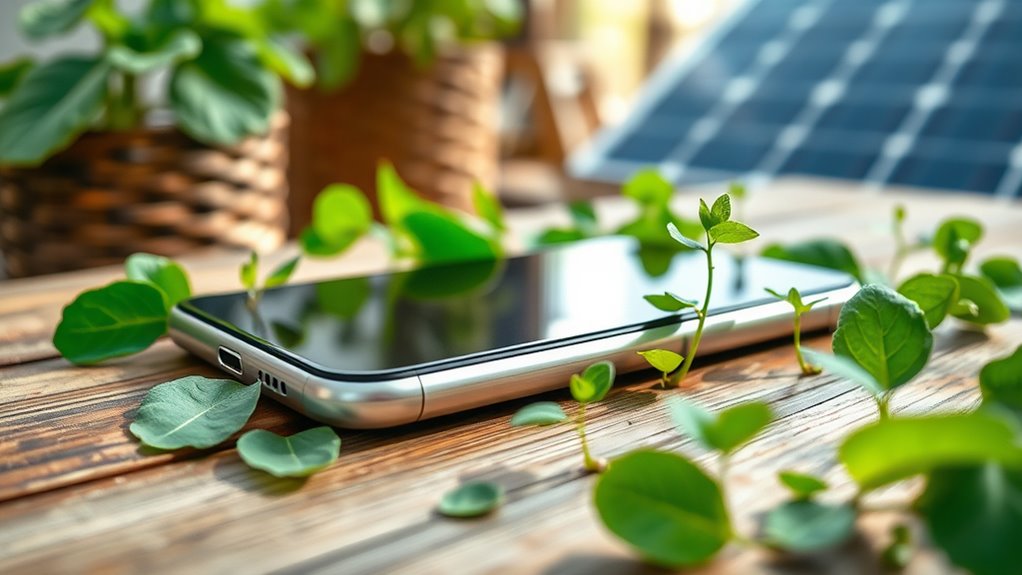If you’re interested in sustainable smartphone brands to watch, Fairphone, Teracube, Apple, and Samsung lead the way. Fairphone and Teracube focus on repairability and eco-friendly designs, while Apple and Samsung incorporate recycled materials and renewable energy practices. Industry trends highlight modular designs and ethical sourcing that extend device life and reduce waste. To discover how these brands are shaping eco-friendly tech, keep exploring the latest innovations and sustainability efforts in mobile manufacturing.
Key Takeaways
- Fairphone leads with modular, repairable designs and circular economy principles, emphasizing ethical sourcing and recycled materials.
- Teracube promotes repairability with screw-based DIY repairs, biodegradable cases, and extended warranties for device longevity.
- Apple integrates over 30% recycled content and aims for fully recycled batteries, reducing environmental impact across its supply chain.
- Samsung commits to ‘Zero Waste to Landfill’, recycling millions of pounds of e-waste and adopting innovative sustainable manufacturing practices.
- Industry trends focus on modularity, recycled materials, and longer warranties to extend device life and reduce electronic waste.
Fairphone: Pioneering Modular and Ethical Manufacturing
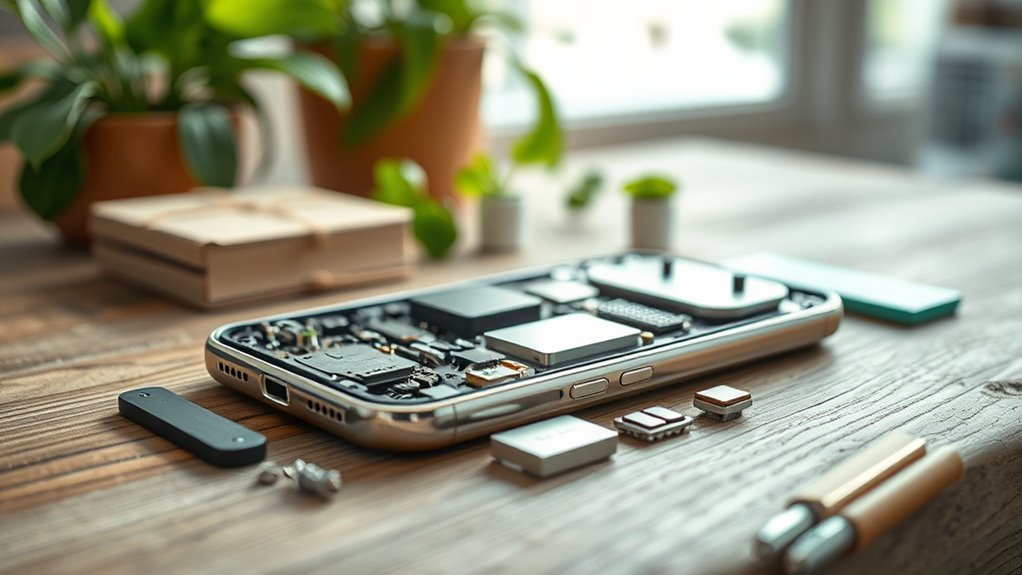
Fairphone is transforming the smartphone industry by prioritizing ethical and sustainable manufacturing practices. You’ll find that their modular design makes repairs and upgrades simple, reducing electronic waste and extending device lifespan. With swappable parts like the Fairphone 5, users can replace components independently, minimizing the need for new devices. The company actively promotes a circular economy by using recycled materials and designing for longevity, helping to combat the global issue of electronic waste—only 15% of smartphones are recycled. Fairphone’s commitment to fair labor conditions, responsible sourcing, and transparent supply chains ensures that ethical practices are embedded at every step. By combining innovative modular technology with a strong ethical philosophy, Fairphone sets a new standard for sustainability in the smartphone industry. Incorporating environmentally conscious manufacturing practices where possible further enhances their commitment to sustainable production methods. Additionally, their focus on ethical sourcing ensures that raw materials are obtained responsibly, reducing environmental impact and supporting fair labor practices. Implementing sustainable supply chain management helps ensure that these ethical standards are maintained throughout all stages of production.
Teracube: Extending Device Lifespan With Repairable Designs
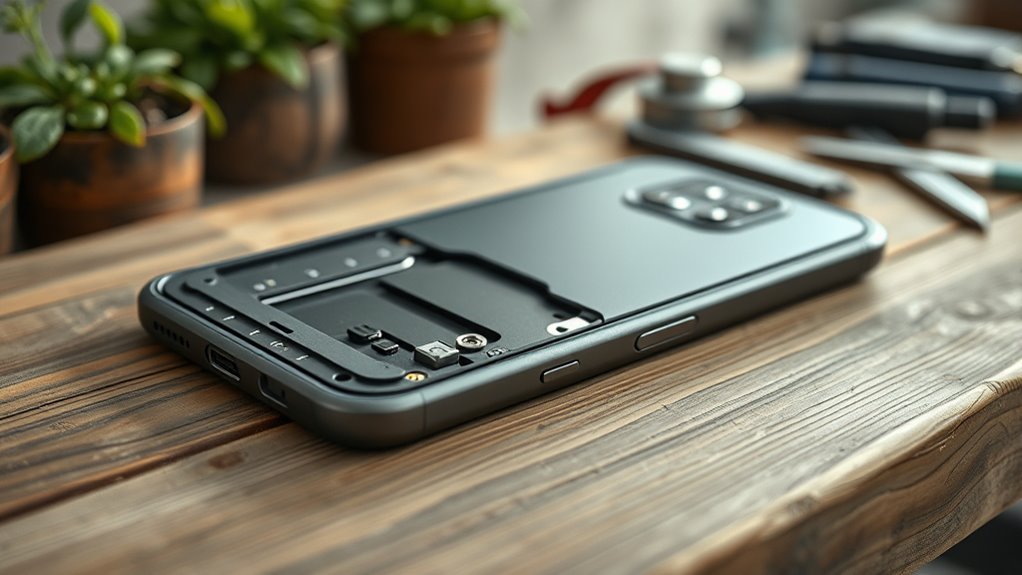
By focusing on repairability and sustainable materials, Teracube extends the lifespan of smartphones and reduces electronic waste. Their phones incorporate 25% recycled polycarbonate, helping lower environmental impact, and come with biodegradable cases for added durability. Designed for disassembly, Teracube uses screws instead of glue, making repairs straightforward. The Teracube 2e features a 4000mAh replaceable battery, encouraging longer device use and less waste. They provide accessible repair guides and promote DIY maintenance, empowering users to keep their phones functional longer. With a 4-year warranty and a focus on long-term value, Teracube aims to minimize electronic waste by enabling users to repair and upgrade their devices instead of discarding them. This approach supports sustainability through durable design and responsible material choices. Additionally, emphasizing repairability helps extend the lifespan of devices and reduces the need for frequent replacements. Incorporating sustainable materials further enhances their commitment to environmentally responsible manufacturing. Moreover, adopting a circular economy approach ensures that resources are reused and recycled efficiently, minimizing environmental impact. Furthermore, their commitment to long-term user engagement underscores their dedication to sustainable practices, aligning with the growing importance of financial management and responsible consumption.
Apple: Advancing Recycled Materials and Sustainable Practices
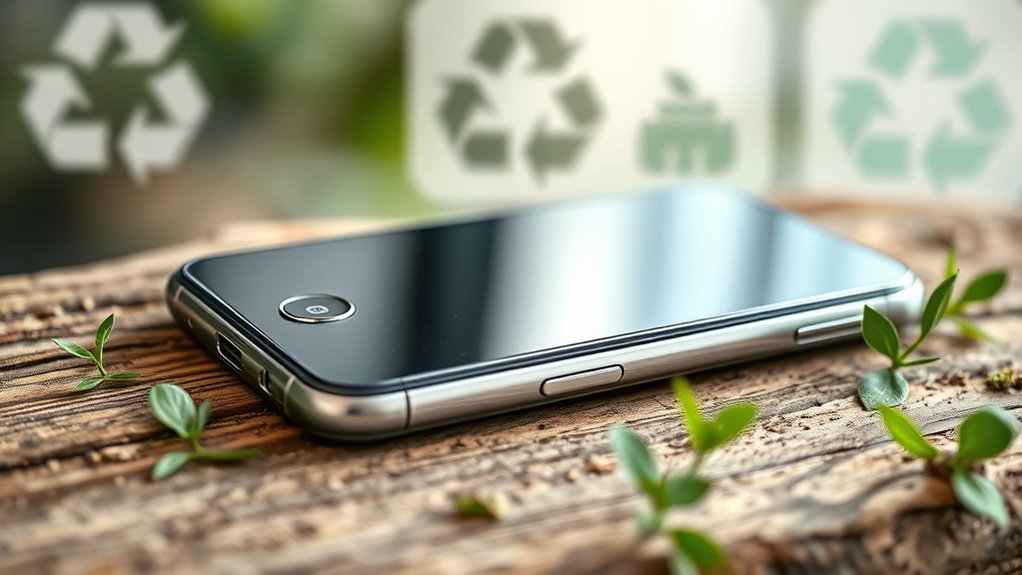
Apple is making significant strides in sustainable manufacturing by integrating recycled and renewable materials into its products. The iPhone 16 and iPhone 16 Plus contain over 30% recycled content, including 85% recycled aluminum in their enclosures. By 2025, Apple aims for 100% recycled cobalt in all its batteries and plans to use recycled tin and gold plating in PCBs. You’ll notice their fiber-based packaging comprises 95% fiber material, with 70% recycled fiber, and responsibly sourced virgin wood fiber. Apple’s supplier initiatives focus on clean energy; over 38% of electricity for iPhone 15 Pro manufacturing comes from renewable sources. They’ve reduced emissions by more than 60% since 2015 and target 100% renewable energy in their supply chain by 2030, supporting a more sustainable future. Incorporating recycled materials not only reduces waste but also lessens the environmental impact of production processes. Additionally, adopting sustainable manufacturing practices helps minimize the carbon footprint of electronics production. Emphasizing environmentally conscious strategies ensures long-term sustainability and resource conservation in their operations. Moreover, embracing innovative recycling technologies can further improve the efficiency of material recovery, reducing reliance on virgin resources. Furthermore, integrating mindfulness techniques into their corporate culture can foster greater environmental awareness among employees, promoting more sustainable decision-making.
Samsung: Leading in Certification and Recycling Initiatives
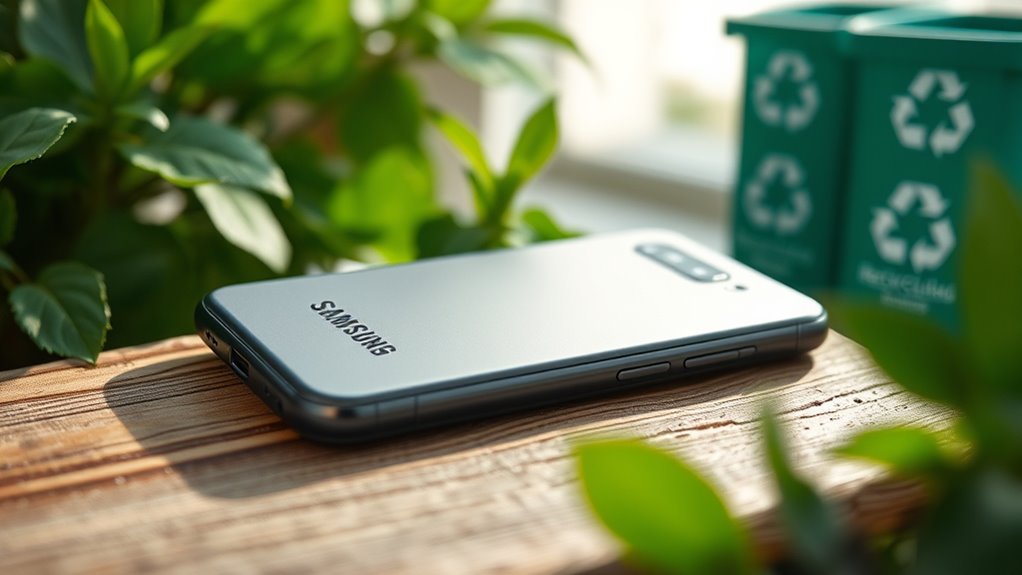
Samsung leads the way in certification and recycling initiatives by setting ambitious goals and implementing all-encompassing programs to reduce environmental impact. You’ll find that they aim for ‘Zero Waste to Landfill’ platinum validation globally by 2025, showcasing their commitment to responsible waste management. Their recycling efforts are impressive—they collect and recycle over 100 million pounds of e-waste annually since 2012, with plans to reach 7.5 million tons by 2030. Samsung also recycles cobalt from used Galaxy phones and batteries, promoting a circular supply chain. Their products meet rigorous environmental standards, with over 600 ENERGY STAR-certified devices. Additionally, they publish detailed sustainability reports for transparency, ensuring consumers and stakeholders stay informed about their ongoing efforts to prioritize eco-friendly practices across all operations. Emphasizing the importance of vibrational alignment in sustainability initiatives further demonstrates their dedication to holistic environmental responsibility. Moreover, their commitment to environmental standards underscores their dedication to responsible manufacturing practices. Incorporating sustainable sourcing into their supply chain is another key aspect of their comprehensive environmental strategy. Their proactive approach is further supported by innovative recycling technologies, which enhance their ability to recover valuable materials efficiently. Their emphasis on compliance with environmental regulations reflects their proactive approach to maintaining high sustainability standards.
Industry Trends: Emphasizing Modularity and Ethical Sourcing
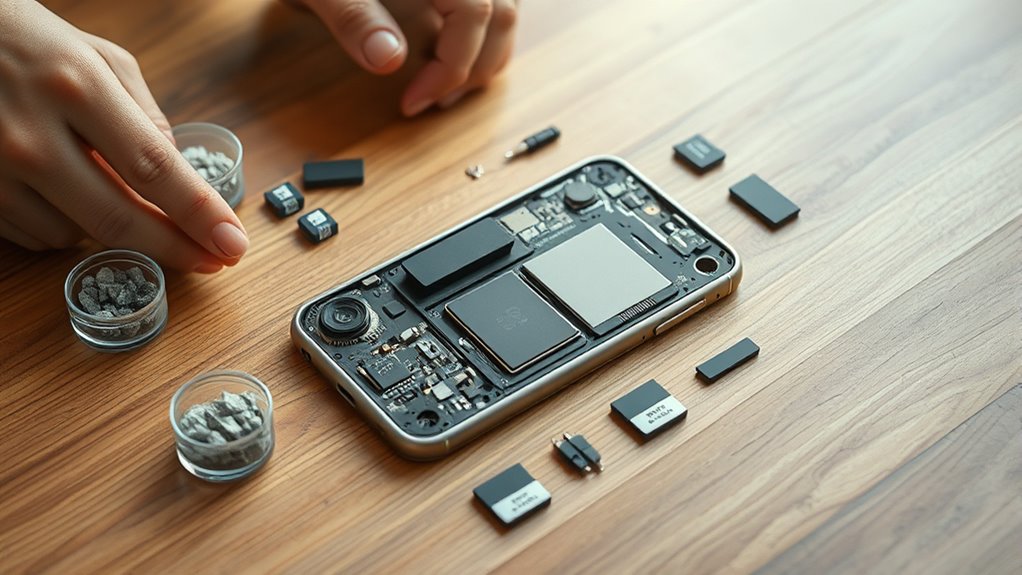
The industry is increasingly adopting modular design and ethical sourcing practices to enhance sustainability. Modular smartphones let you replace or upgrade individual parts, which extends device lifespan and cuts electronic waste. Brands like Fairphone lead the way, making it easy for users to swap batteries, cameras, or screens. This design promotes DIY repairs, fostering a more sustainable relationship with devices. Meanwhile, companies are incorporating recycled materials, such as metals and plastics, to reduce reliance on virgin resources and lower environmental footprints. Apple and Google exemplify this shift, using recycled aluminum and rare earth elements. Ethical sourcing also involves energy-efficient manufacturing processes, reducing emissions. Additionally, sustainable manufacturing practices are being refined to incorporate circular economy principles, further minimizing waste. These trends not only make devices more sustainable but also align with consumer demands for eco-friendly technology, signaling a significant shift toward responsible smartphone production. Furthermore, ongoing advancements in sustainable manufacturing practices are expected to further minimize environmental impacts across the industry.
Consumer Influence: Shifting Preferences Toward Sustainable Brands
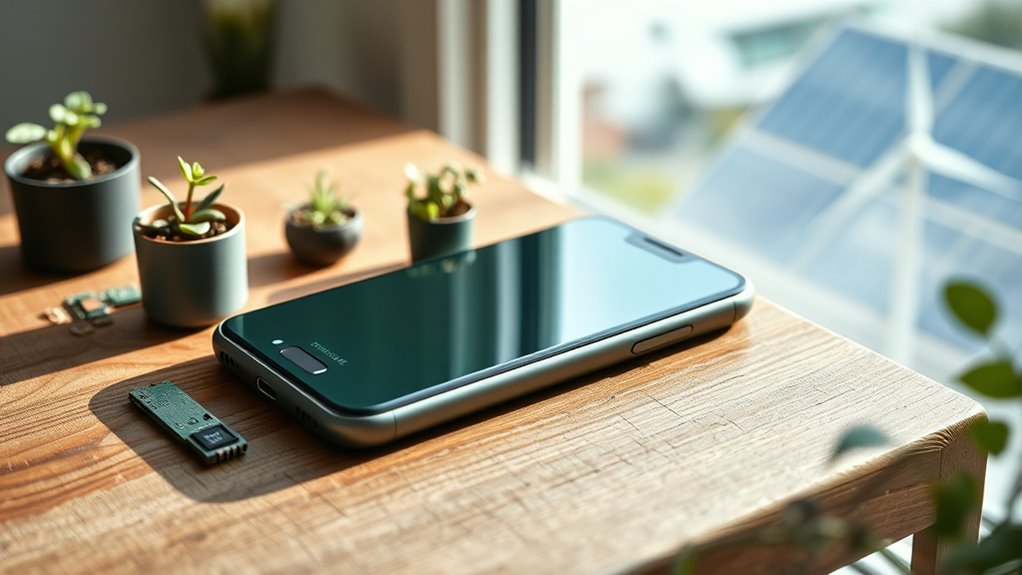
As awareness of environmental issues grows, consumers are increasingly expecting brands to demonstrate genuine sustainability efforts. You recognize that your choices influence companies’ priorities, especially as 75% of Britons agree lifestyle changes are needed to prevent environmental damage. Consumers now see smartphones as an extension of their commitment to sustainability, but resistance remains; brands like Fairphone hold less than 1% market share in the EU and US. You’re holding onto devices longer, reducing waste and saving money, while nearly 70% of Germans believe tech companies should produce greener products. Your purchasing decisions are increasingly influenced by environmental factors, with almost 40% of German smartphone owners considering eco-friendliness before buying. Your social norms and preferences drive brands to adopt transparent, sustainable practices to stay competitive and meet your expectations. Incorporating sustainable manufacturing practices can also help brands improve their reputation and appeal to environmentally conscious consumers. Additionally, cultural influences from regions where traditional celebrations like Halloween are gaining popularity can encourage brands to align their marketing with local values of sustainability.
Material Innovation: From Recycled Plastics to Ethically Sourced Components

Innovative material sourcing is transforming smartphone manufacturing by prioritizing recycled and ethically obtained components. Brands like Apple, Samsung, and Google are increasingly using recycled metals and plastics, reducing reliance on virgin resources and cutting emissions from extraction. Recycled plastics from sources like fishing nets are integrated into device parts, while rare earth elements recovered from recycled materials power essential components. Ethically sourced minerals such as cobalt, tin, and tantalum come from conflict-free mines, ensuring fair labor practices and transparency. Manufacturers also adopt biodegradable packaging, using recycled paper and vegetable-based inks, to cut waste and emissions. Modular designs with sustainable materials allow easier repair and component reuse, extending device lifespan. These innovations demonstrate a shift toward responsible sourcing, aligning manufacturing with environmental and social sustainability goals.
Warranties and Repairability: Encouraging Longer Device Use
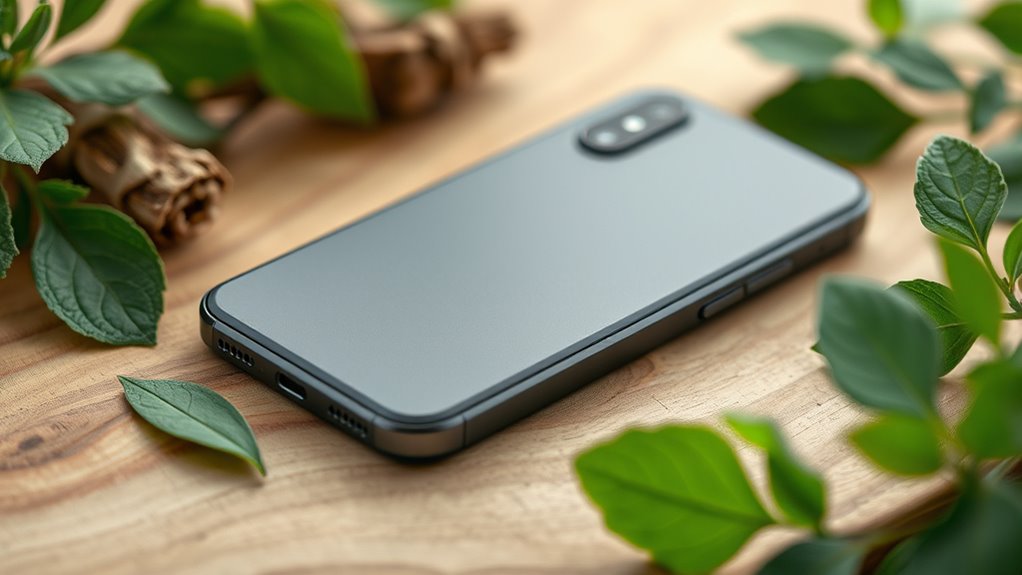
Warranties and repairability play a crucial role in encouraging longer device use and promoting sustainability. When brands like Fairphone offer extended warranties—up to five years—they motivate you to keep your device longer, reducing the need for frequent replacements. Repair options and accessible guides empower you to perform repairs yourself, extending your phone’s lifespan and cutting electronic waste. Modular designs and readily available spare parts make repairs simpler, while some models feature tool-free disassembly. Longer warranties and repairability foster trust and satisfaction, encouraging sustainable purchasing habits. By extending device life, you help lower resource extraction, decrease your carbon footprint, and minimize waste. Overall, these practices support a shift toward more responsible consumption, benefiting both you and the environment.
Recycling Programs and Trade-In Schemes: Reducing E-Waste
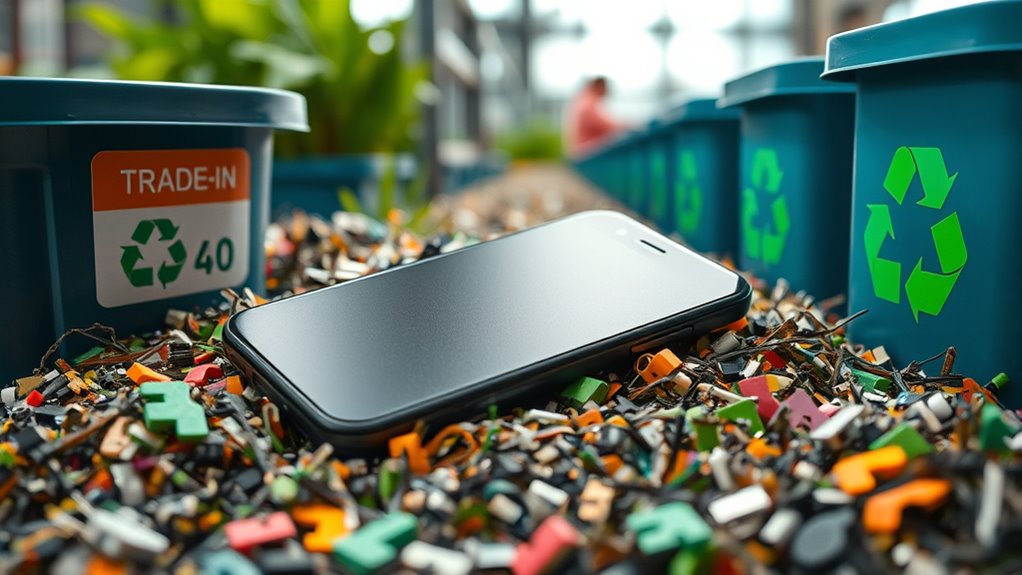
Recycling programs and trade-in schemes are vital tools for reducing electronic waste and conserving valuable resources. When you recycle or trade in your old phone, you help recover metals like copper, silver, gold, and palladium, which reduces the need for environmentally damaging mining. Currently, only about 15% of phones in the U.S. are recycled, indicating significant lost potential. Many consumers prefer storing old devices or reselling them, but low participation in formal programs limits waste reduction. Incentive schemes, such as discounts for trading in phones, can boost collection rates, though engagement remains modest. Effective programs lower greenhouse gas emissions, create jobs, and support a circular economy. Public awareness and transparent reporting are essential to increasing consumer participation and maximizing environmental benefits.
Future Outlook: Innovations and Standards Shaping Sustainable Mobile Tech
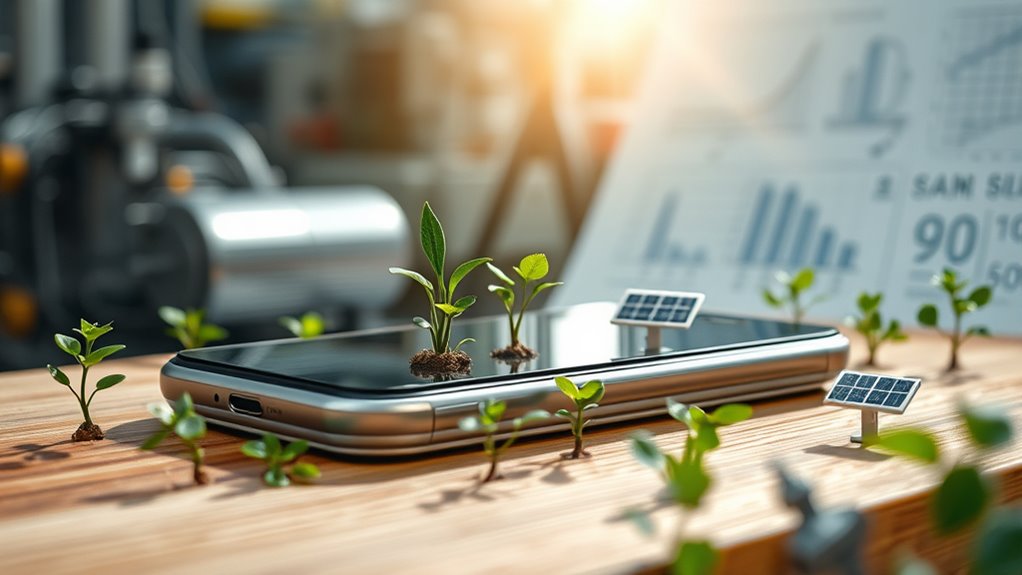
As technology advances, manufacturers and regulators are setting new standards that drive sustainability in mobile device production. Innovations in sustainable materials, like recycled metals and biodegradable components, are reducing reliance on virgin resources and lowering emissions. Brands such as Apple and Google are already incorporating recycled aluminum and rare earth elements into their devices. Energy efficiency improvements, including advanced processors and longer-lasting batteries, cut power consumption and environmental impact. Modular designs promote repairability and extend device lifespan, while support for right-to-repair initiatives simplifies upgrades and recycling. Emerging regulations push for higher recycled content, transparency, and international standards, fostering industry accountability. Consumer demand for eco-friendly products and market growth for refurbished devices further accelerate sustainable innovation, shaping a greener future for mobile technology.
Frequently Asked Questions
How Do Repairability Scores Influence Consumer Purchasing Decisions?
Repairability scores directly influence your purchasing decisions by highlighting how easy it is to fix a smartphone. You’re more likely to choose devices with high scores because they promise longer longevity, lower repair costs, and better access to spare parts and guides. These labels build trust, reduce frustration, and align with your values for sustainability and right-to-repair, making high-scoring phones your preferred choice in a competitive market.
What Challenges Do Brands Face in Sourcing Ethical Materials at Scale?
When it comes to sourcing ethical materials at scale, you hit a wall with limited supply and high costs. The supply chain is a tangled web, making transparency and ensuring ethical standards tough to verify. Recycled and sustainable options often don’t meet durability needs, and regulatory hurdles add more fuel to the fire. You have to balance ethical sourcing with economic realities, often walking a tightrope between cost and conscience.
How Are Certifications Like EPEAT Impacting Brand Credibility?
Certifications like EPEAT boost your brand’s credibility by showcasing your commitment to sustainability and transparency. When your products earn EPEAT certification, you demonstrate compliance with strict environmental standards, making it easier to gain trust from consumers and institutional buyers. It also differentiates your brand in a competitive market, aligning with global sustainability trends and regulatory expectations. Ultimately, these certifications reinforce your reputation as a responsible and environmentally conscious manufacturer.
What Role Do Consumer Repair Kits Play in Sustainability Efforts?
Consumer repair kits play a crucial role in sustainability by making it easier for you to fix and upgrade your smartphone. They extend device lifespan, reduce electronic waste, and lower the demand for resource-intensive manufacturing. By empowering you to repair your device yourself, these kits promote a circular economy mindset, decrease reliance on professional repairs, and encourage more sustainable consumer behavior, ultimately supporting environmental conservation and responsible tech use.
How Will Future Regulations Shape Sustainable Smartphone Manufacturing Standards?
Future regulations will substantially shape sustainable smartphone manufacturing standards. You’ll need to design devices for durability, repairability, and recyclability, with spare parts available for years. Extended software support will keep devices usable longer, reducing waste. Stricter environmental and social certifications will push you to use sustainable materials and improve labor conditions. Embracing these standards early can give you a competitive edge, boost brand loyalty, and meet global market demands for eco-friendly products.
Conclusion
As you explore sustainable smartphones, remember that every choice you make can transform the industry. These brands are leading a revolution so powerful, it could reshape our planet’s future. By supporting ethical sourcing, repairability, and recycling, you’re not just upgrading your device—you’re fueling a movement that might just save the world from digital waste. Stay informed, choose wisely, and be part of this groundbreaking shift toward a greener, more responsible mobile future.
